

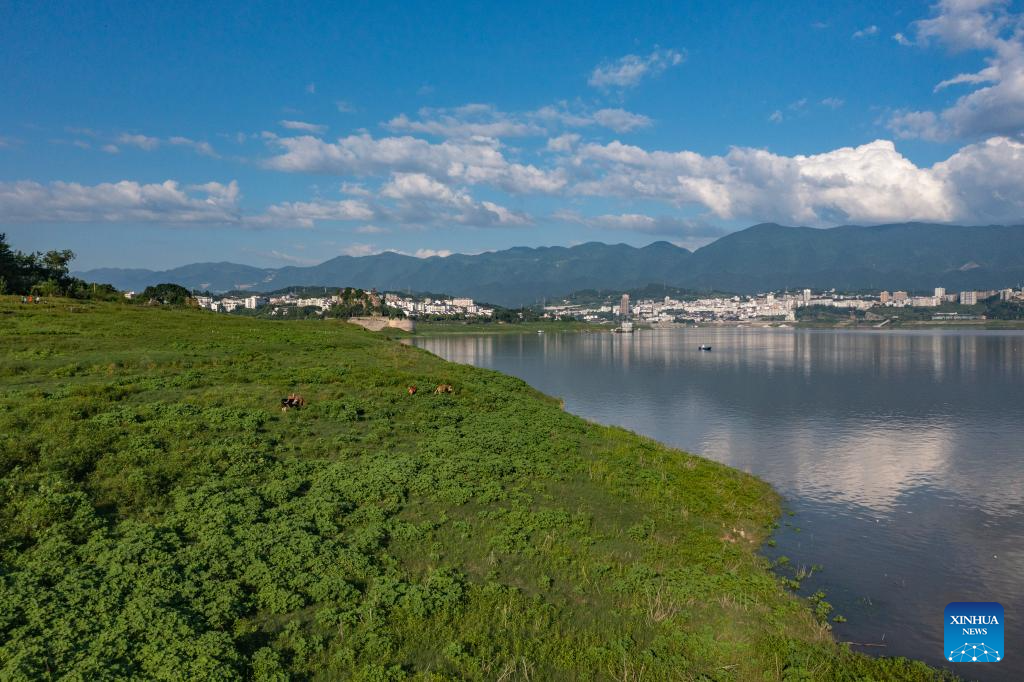
This aerial photo taken on July 5, 2023 shows an area of the Three Gorges Reservoir in Zhongxian County, southwest China's Chongqing.
The Three Gorges Reservoir region, home to the world's largest hydropower project, covers about 10,000 square km along the Yangtze River, China's longest waterway.
The seasonal gaps in the reservoir's water levels have resulted in a water-level fluctuation zone covering 349 square kilometers along the Yangtze River. The zone suffers environmental problems, including soil erosion and pollution.
Researchers of the Institute of Mountain Hazards and Environment under CAS have, since 2007, conducted a raft of studies on soil erosion, non-point source pollution, and ecological restoration of the water-level fluctuation zone in the reservoir area.
In recent years, the ecological environment of the reservoir area has improved and the soil erosion in the water-level fluctuation zone has gradually reduced. (Xinhua/Huang Wei)
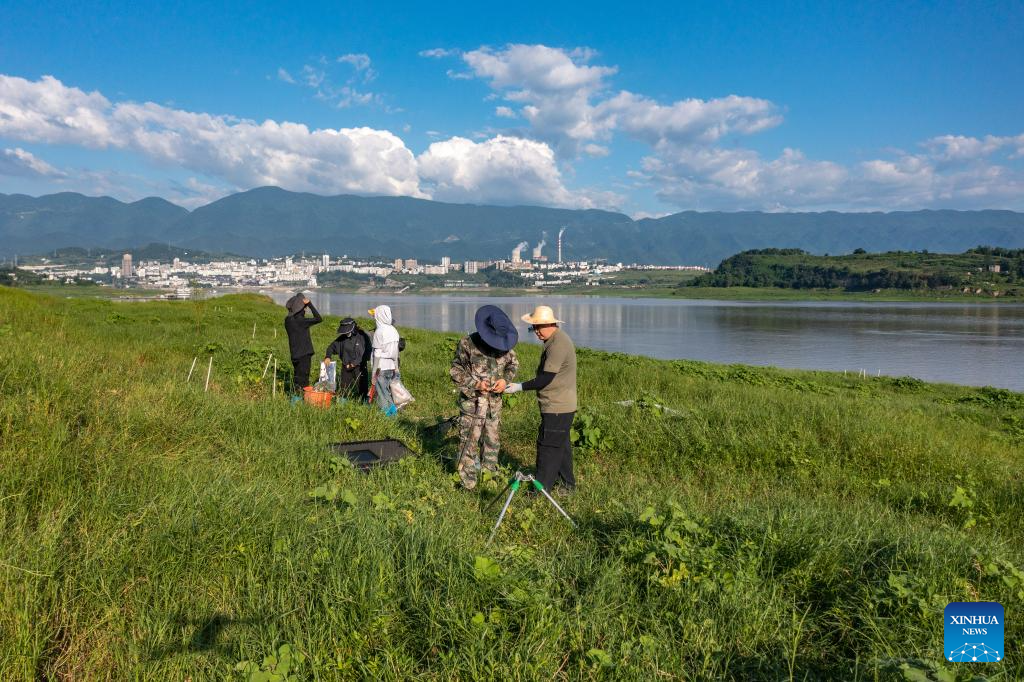
In this aerial photo, researchers of the Institute of Mountain Hazards and Environment under Chinese Academy of Sciences (CAS) carry out scientific monitoring at a water-level fluctuation zone of the Three Gorges Reservoir in Zhongxian County, southwest China's Chongqing, July 5, 2023.
The Three Gorges Reservoir region, home to the world's largest hydropower project, covers about 10,000 square km along the Yangtze River, China's longest waterway.
The seasonal gaps in the reservoir's water levels have resulted in a water-level fluctuation zone covering 349 square kilometers along the Yangtze River. The zone suffers environmental problems, including soil erosion and pollution.
Researchers of the Institute of Mountain Hazards and Environment under CAS have, since 2007, conducted a raft of studies on soil erosion, non-point source pollution, and ecological restoration of the water-level fluctuation zone in the reservoir area.
In recent years, the ecological environment of the reservoir area has improved and the soil erosion in the water-level fluctuation zone has gradually reduced. (Xinhua/Huang Wei)

Researchers of the Institute of Mountain Hazards and Environment under Chinese Academy of Sciences (CAS) assess water-stable soil aggregate at a research station in Zhongxian County, southwest China's Chongqing, July 5, 2023.
The Three Gorges Reservoir region, home to the world's largest hydropower project, covers about 10,000 square km along the Yangtze River, China's longest waterway.
The seasonal gaps in the reservoir's water levels have resulted in a water-level fluctuation zone covering 349 square kilometers along the Yangtze River. The zone suffers environmental problems, including soil erosion and pollution.
Researchers of the Institute of Mountain Hazards and Environment under CAS have, since 2007, conducted a raft of studies on soil erosion, non-point source pollution, and ecological restoration of the water-level fluctuation zone in the reservoir area.
In recent years, the ecological environment of the reservoir area has improved and the soil erosion in the water-level fluctuation zone has gradually reduced. (Xinhua/Chu Jiayin)
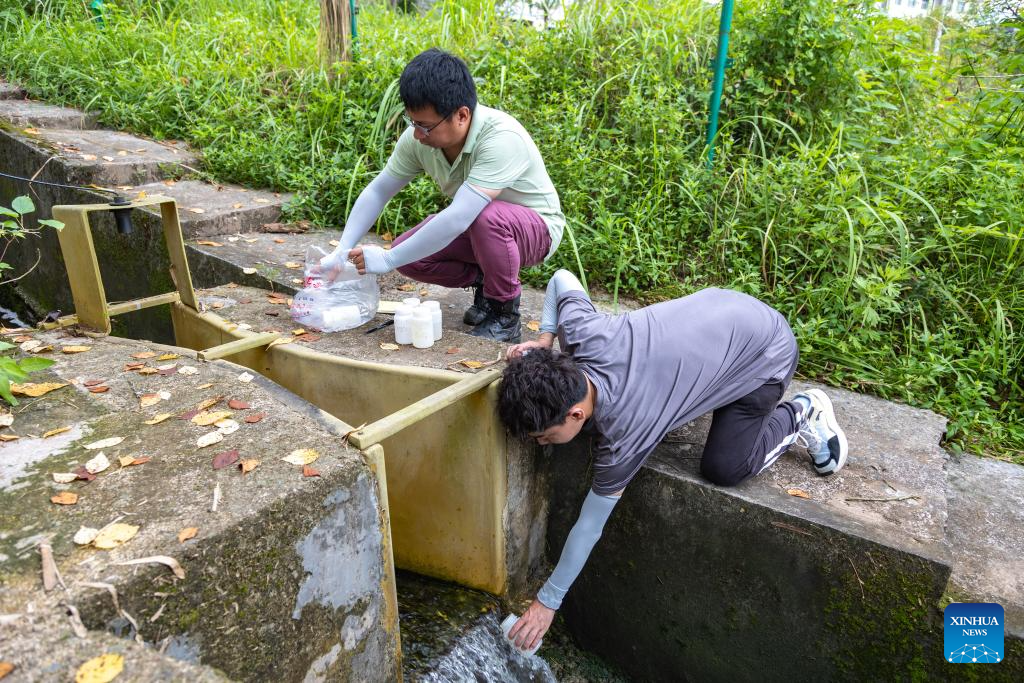
Researchers of the Institute of Mountain Hazards and Environment under Chinese Academy of Sciences (CAS) collect water samples in Zhongxian County, southwest China's Chongqing, July 6, 2023.
The Three Gorges Reservoir region, home to the world's largest hydropower project, covers about 10,000 square km along the Yangtze River, China's longest waterway.
The seasonal gaps in the reservoir's water levels have resulted in a water-level fluctuation zone covering 349 square kilometers along the Yangtze River. The zone suffers environmental problems, including soil erosion and pollution.
Researchers of the Institute of Mountain Hazards and Environment under CAS have, since 2007, conducted a raft of studies on soil erosion, non-point source pollution, and ecological restoration of the water-level fluctuation zone in the reservoir area.
In recent years, the ecological environment of the reservoir area has improved and the soil erosion in the water-level fluctuation zone has gradually reduced. (Xinhua/Huang Wei)
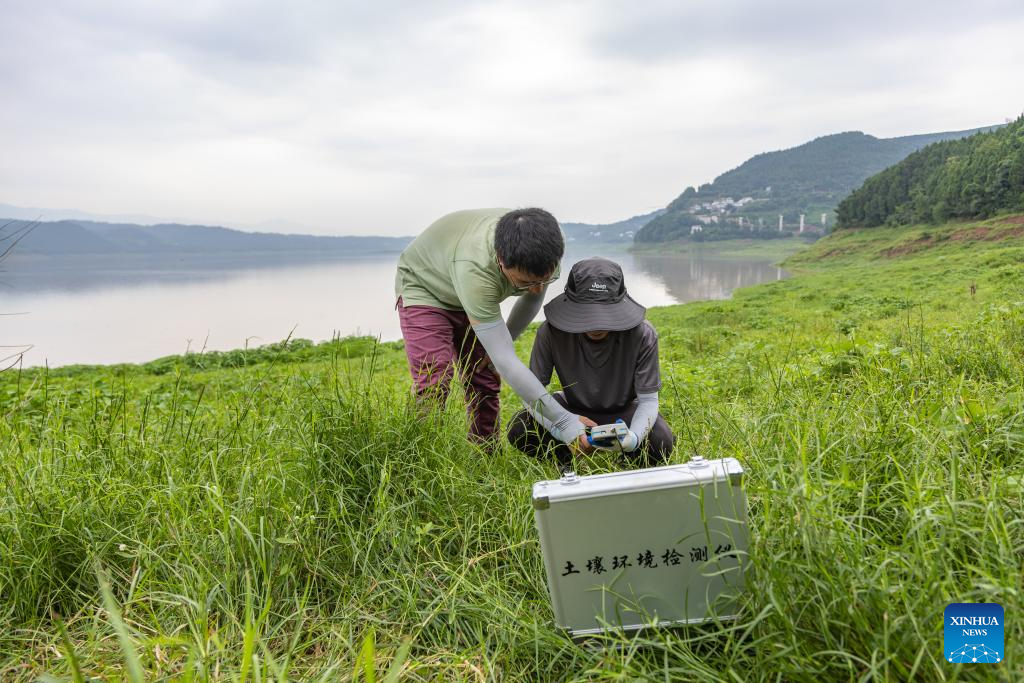
Researchers of the Institute of Mountain Hazards and Environment under Chinese Academy of Sciences (CAS) measure soil temperature and humidity at a water-level fluctuation zone of the Three Gorges Reservoir in Zhongxian County, southwest China's Chongqing, July 6, 2023.
The Three Gorges Reservoir region, home to the world's largest hydropower project, covers about 10,000 square km along the Yangtze River, China's longest waterway.
The seasonal gaps in the reservoir's water levels have resulted in a water-level fluctuation zone covering 349 square kilometers along the Yangtze River. The zone suffers environmental problems, including soil erosion and pollution.
Researchers of the Institute of Mountain Hazards and Environment under CAS have, since 2007, conducted a raft of studies on soil erosion, non-point source pollution, and ecological restoration of the water-level fluctuation zone in the reservoir area.
In recent years, the ecological environment of the reservoir area has improved and the soil erosion in the water-level fluctuation zone has gradually reduced. (Xinhua/Huang Wei)
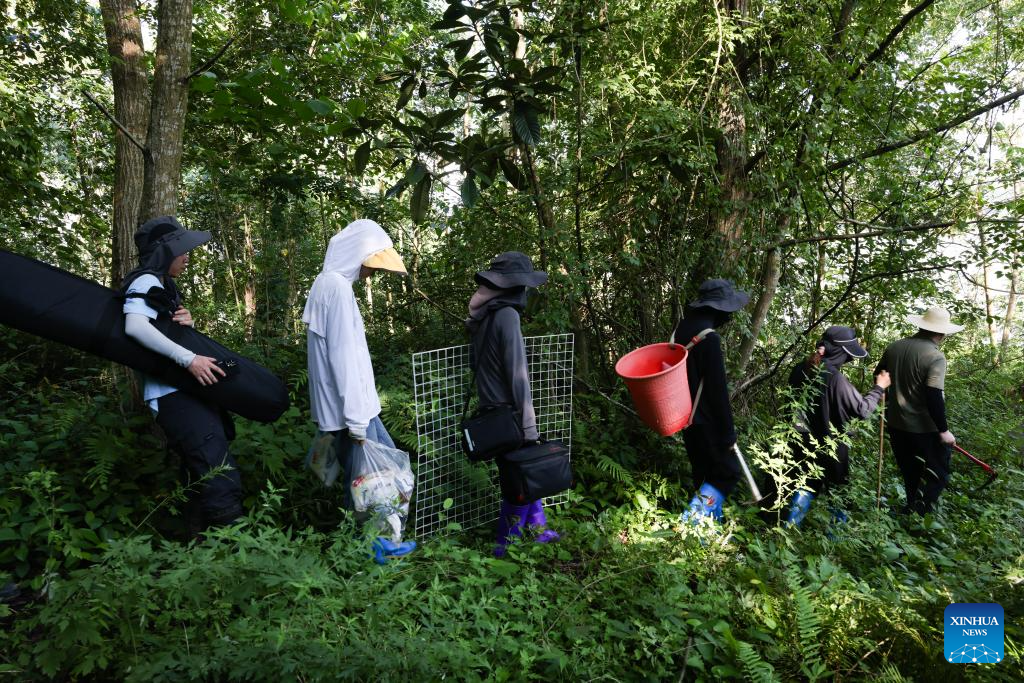
Researchers of the Institute of Mountain Hazards and Environment under Chinese Academy of Sciences (CAS) walk to a water-level fluctuation zone of the Three Gorges Reservoir in Zhongxian County, southwest China's Chongqing, July 5, 2023.
The Three Gorges Reservoir region, home to the world's largest hydropower project, covers about 10,000 square km along the Yangtze River, China's longest waterway.
The seasonal gaps in the reservoir's water levels have resulted in a water-level fluctuation zone covering 349 square kilometers along the Yangtze River. The zone suffers environmental problems, including soil erosion and pollution.
Researchers of the Institute of Mountain Hazards and Environment under CAS have, since 2007, conducted a raft of studies on soil erosion, non-point source pollution, and ecological restoration of the water-level fluctuation zone in the reservoir area.
In recent years, the ecological environment of the reservoir area has improved and the soil erosion in the water-level fluctuation zone has gradually reduced. (Xinhua/Jin Liwang)

Researchers of the Institute of Mountain Hazards and Environment under Chinese Academy of Sciences (CAS) walk to a water-level fluctuation zone of the Three Gorges Reservoir in Zhongxian County, southwest China's Chongqing, July 5, 2023.
The Three Gorges Reservoir region, home to the world's largest hydropower project, covers about 10,000 square km along the Yangtze River, China's longest waterway.
The seasonal gaps in the reservoir's water levels have resulted in a water-level fluctuation zone covering 349 square kilometers along the Yangtze River. The zone suffers environmental problems, including soil erosion and pollution.
Researchers of the Institute of Mountain Hazards and Environment under CAS have, since 2007, conducted a raft of studies on soil erosion, non-point source pollution, and ecological restoration of the water-level fluctuation zone in the reservoir area.
In recent years, the ecological environment of the reservoir area has improved and the soil erosion in the water-level fluctuation zone has gradually reduced. (Xinhua/Chu Jiayin)
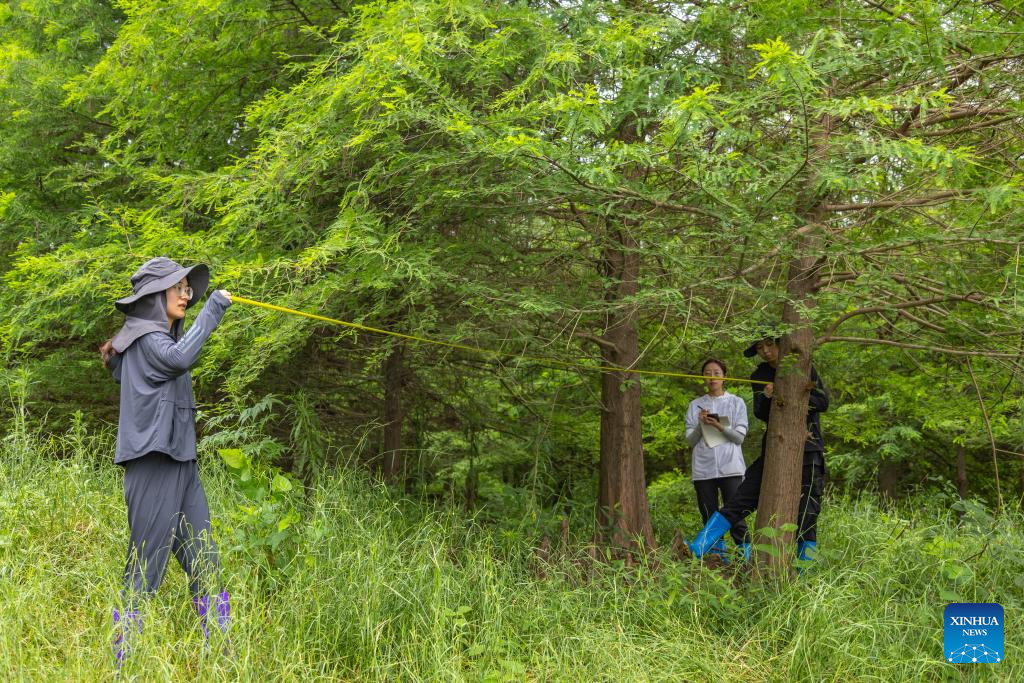
Researchers of the Institute of Mountain Hazards and Environment under Chinese Academy of Sciences (CAS) check the growth of pond cypress trees at a water-level fluctuation zone of the Three Gorges Reservoir in Zhongxian County, southwest China's Chongqing, July 6, 2023.
The Three Gorges Reservoir region, home to the world's largest hydropower project, covers about 10,000 square km along the Yangtze River, China's longest waterway.
The seasonal gaps in the reservoir's water levels have resulted in a water-level fluctuation zone covering 349 square kilometers along the Yangtze River. The zone suffers environmental problems, including soil erosion and pollution.
Researchers of the Institute of Mountain Hazards and Environment under CAS have, since 2007, conducted a raft of studies on soil erosion, non-point source pollution, and ecological restoration of the water-level fluctuation zone in the reservoir area.
In recent years, the ecological environment of the reservoir area has improved and the soil erosion in the water-level fluctuation zone has gradually reduced. (Xinhua/Huang Wei)
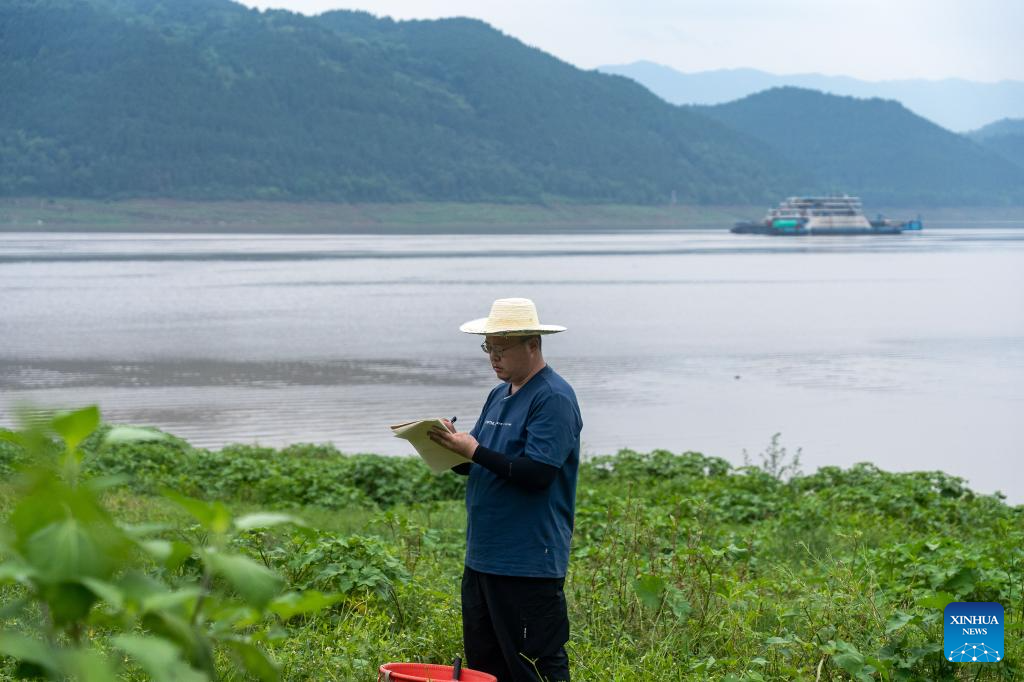
A researcher of the Institute of Mountain Hazards and Environment under Chinese Academy of Sciences (CAS) carries out scientific monitoring at a water-level fluctuation zone of the Three Gorges Reservoir in Zhongxian County, southwest China's Chongqing, July 6, 2023.
The Three Gorges Reservoir region, home to the world's largest hydropower project, covers about 10,000 square km along the Yangtze River, China's longest waterway.
The seasonal gaps in the reservoir's water levels have resulted in a water-level fluctuation zone covering 349 square kilometers along the Yangtze River. The zone suffers environmental problems, including soil erosion and pollution.
Researchers of the Institute of Mountain Hazards and Environment under CAS have, since 2007, conducted a raft of studies on soil erosion, non-point source pollution, and ecological restoration of the water-level fluctuation zone in the reservoir area.
In recent years, the ecological environment of the reservoir area has improved and the soil erosion in the water-level fluctuation zone has gradually reduced. (Xinhua/Zhou Dixiao)

Researchers of the Institute of Mountain Hazards and Environment under Chinese Academy of Sciences (CAS) carry out scientific monitoring at a water-level fluctuation zone of the Three Gorges Reservoir in Zhongxian County, southwest China's Chongqing, July 5, 2023.
The Three Gorges Reservoir region, home to the world's largest hydropower project, covers about 10,000 square km along the Yangtze River, China's longest waterway.
The seasonal gaps in the reservoir's water levels have resulted in a water-level fluctuation zone covering 349 square kilometers along the Yangtze River. The zone suffers environmental problems, including soil erosion and pollution.
Researchers of the Institute of Mountain Hazards and Environment under CAS have, since 2007, conducted a raft of studies on soil erosion, non-point source pollution, and ecological restoration of the water-level fluctuation zone in the reservoir area.
In recent years, the ecological environment of the reservoir area has improved and the soil erosion in the water-level fluctuation zone has gradually reduced. (Xinhua/Jin Liwang)

Researchers of the Institute of Mountain Hazards and Environment under Chinese Academy of Sciences (CAS) process soil samples at a research station in Zhongxian County, southwest China's Chongqing, July 5, 2023.
The Three Gorges Reservoir region, home to the world's largest hydropower project, covers about 10,000 square km along the Yangtze River, China's longest waterway.
The seasonal gaps in the reservoir's water levels have resulted in a water-level fluctuation zone covering 349 square kilometers along the Yangtze River. The zone suffers environmental problems, including soil erosion and pollution.
Researchers of the Institute of Mountain Hazards and Environment under CAS have, since 2007, conducted a raft of studies on soil erosion, non-point source pollution, and ecological restoration of the water-level fluctuation zone in the reservoir area.
In recent years, the ecological environment of the reservoir area has improved and the soil erosion in the water-level fluctuation zone has gradually reduced. (Xinhua/Jin Liwang)

Researchers of the Institute of Mountain Hazards and Environment under Chinese Academy of Sciences (CAS) carry out scientific monitoring at a water-level fluctuation zone of the Three Gorges Reservoir in Zhongxian County, southwest China's Chongqing, July 5, 2023.
The Three Gorges Reservoir region, home to the world's largest hydropower project, covers about 10,000 square km along the Yangtze River, China's longest waterway.
The seasonal gaps in the reservoir's water levels have resulted in a water-level fluctuation zone covering 349 square kilometers along the Yangtze River. The zone suffers environmental problems, including soil erosion and pollution.
Researchers of the Institute of Mountain Hazards and Environment under CAS have, since 2007, conducted a raft of studies on soil erosion, non-point source pollution, and ecological restoration of the water-level fluctuation zone in the reservoir area.
In recent years, the ecological environment of the reservoir area has improved and the soil erosion in the water-level fluctuation zone has gradually reduced. (Xinhua/Jin Liwang)
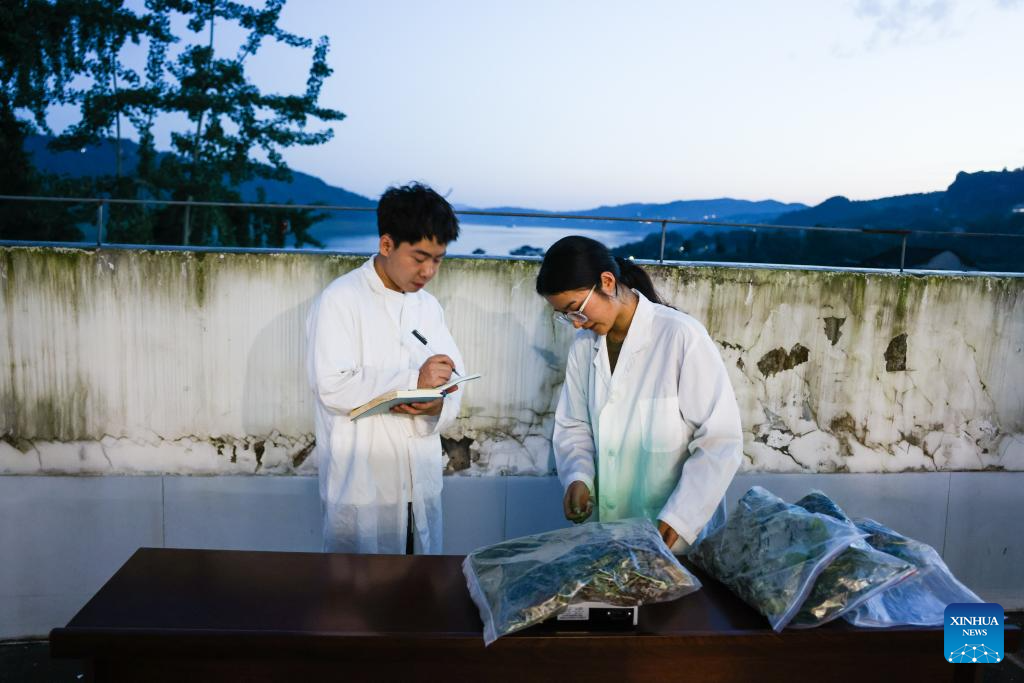
Researchers of the Institute of Mountain Hazards and Environment under Chinese Academy of Sciences (CAS) measure the fresh weight of plants at a research station in Zhongxian County, southwest China's Chongqing, July 5, 2023.
The Three Gorges Reservoir region, home to the world's largest hydropower project, covers about 10,000 square km along the Yangtze River, China's longest waterway.
The seasonal gaps in the reservoir's water levels have resulted in a water-level fluctuation zone covering 349 square kilometers along the Yangtze River. The zone suffers environmental problems, including soil erosion and pollution.
Researchers of the Institute of Mountain Hazards and Environment under CAS have, since 2007, conducted a raft of studies on soil erosion, non-point source pollution, and ecological restoration of the water-level fluctuation zone in the reservoir area.
In recent years, the ecological environment of the reservoir area has improved and the soil erosion in the water-level fluctuation zone has gradually reduced. (Xinhua/Jin Liwang)

Researchers of the Institute of Mountain Hazards and Environment under Chinese Academy of Sciences (CAS) walk to a water-level fluctuation zone of the Three Gorges Reservoir in Zhongxian County, southwest China's Chongqing, July 6, 2023.
The Three Gorges Reservoir region, home to the world's largest hydropower project, covers about 10,000 square km along the Yangtze River, China's longest waterway.
The seasonal gaps in the reservoir's water levels have resulted in a water-level fluctuation zone covering 349 square kilometers along the Yangtze River. The zone suffers environmental problems, including soil erosion and pollution.
Researchers of the Institute of Mountain Hazards and Environment under CAS have, since 2007, conducted a raft of studies on soil erosion, non-point source pollution, and ecological restoration of the water-level fluctuation zone in the reservoir area.
In recent years, the ecological environment of the reservoir area has improved and the soil erosion in the water-level fluctuation zone has gradually reduced. (Xinhua/Huang Wei)

Researchers of the Institute of Mountain Hazards and Environment under Chinese Academy of Sciences (CAS) collect soil samples at a water-level fluctuation zone of the Three Gorges Reservoir in Zhongxian County, southwest China's Chongqing, July 6, 2023.
The Three Gorges Reservoir region, home to the world's largest hydropower project, covers about 10,000 square km along the Yangtze River, China's longest waterway.
The seasonal gaps in the reservoir's water levels have resulted in a water-level fluctuation zone covering 349 square kilometers along the Yangtze River. The zone suffers environmental problems, including soil erosion and pollution.
Researchers of the Institute of Mountain Hazards and Environment under CAS have, since 2007, conducted a raft of studies on soil erosion, non-point source pollution, and ecological restoration of the water-level fluctuation zone in the reservoir area.
In recent years, the ecological environment of the reservoir area has improved and the soil erosion in the water-level fluctuation zone has gradually reduced. (Xinhua/Huang Wei)
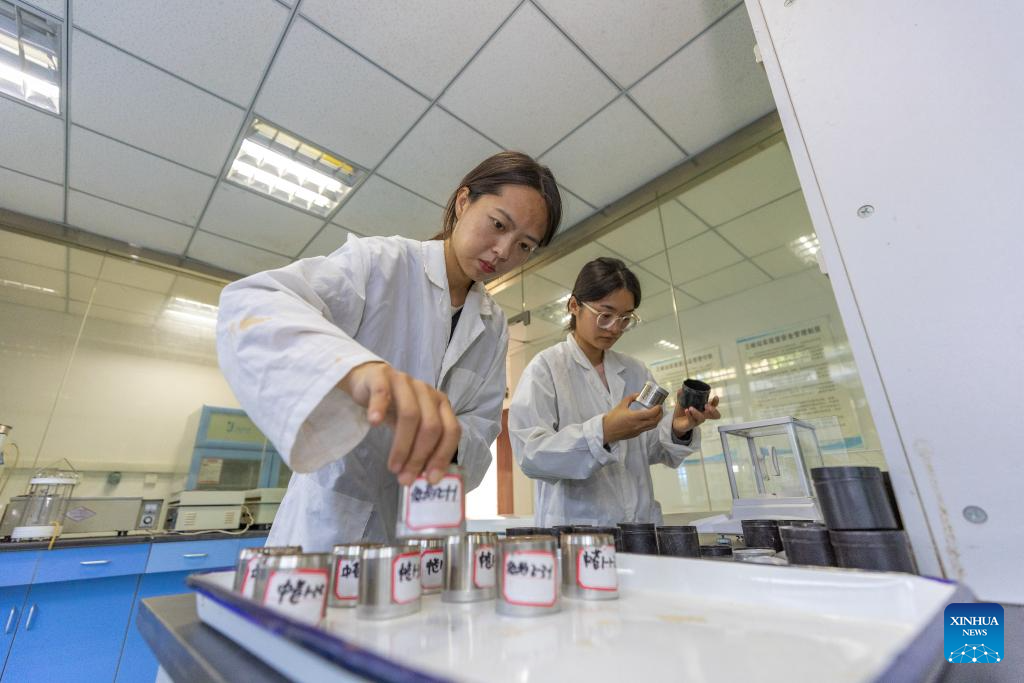
Researchers of the Institute of Mountain Hazards and Environment under Chinese Academy of Sciences (CAS) measure soil porosity at a research station in Zhongxian County, southwest China's Chongqing, July 5, 2023.
The Three Gorges Reservoir region, home to the world's largest hydropower project, covers about 10,000 square km along the Yangtze River, China's longest waterway.
The seasonal gaps in the reservoir's water levels have resulted in a water-level fluctuation zone covering 349 square kilometers along the Yangtze River. The zone suffers environmental problems, including soil erosion and pollution.
Researchers of the Institute of Mountain Hazards and Environment under CAS have, since 2007, conducted a raft of studies on soil erosion, non-point source pollution, and ecological restoration of the water-level fluctuation zone in the reservoir area.
In recent years, the ecological environment of the reservoir area has improved and the soil erosion in the water-level fluctuation zone has gradually reduced. (Xinhua/Huang Wei)
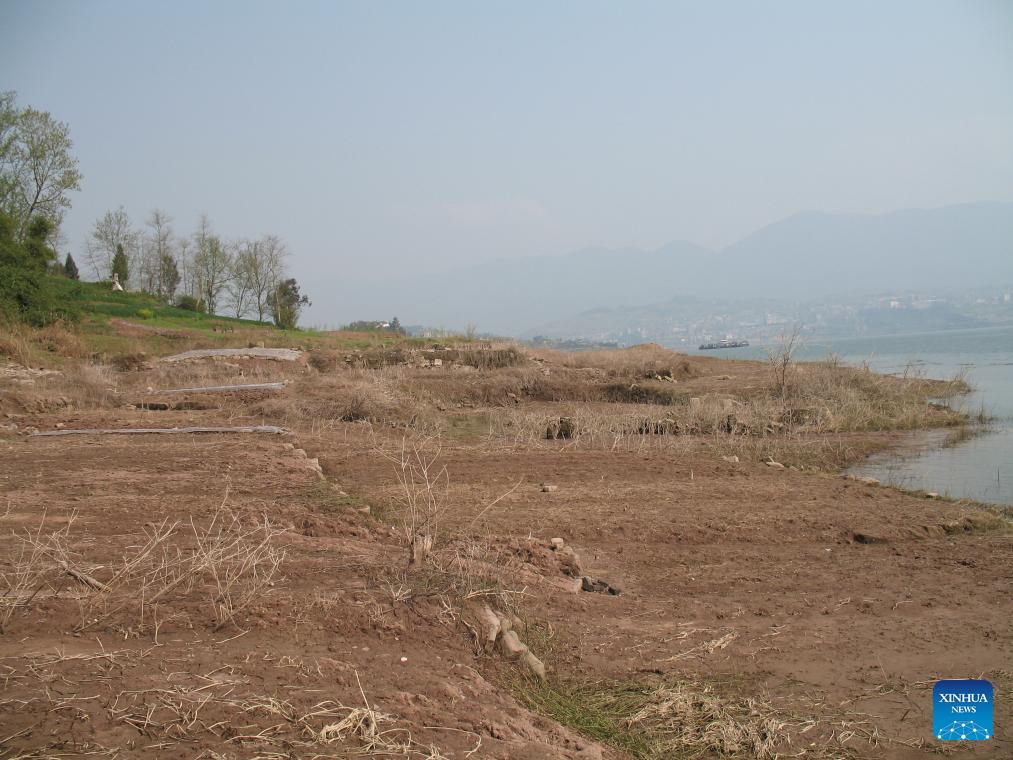
This file photo taken in March 2009 shows an area of the Three Gorges Reservoir in Zhongxian County, southwest China's Chongqing.
The Three Gorges Reservoir region, home to the world's largest hydropower project, covers about 10,000 square km along the Yangtze River, China's longest waterway.
The seasonal gaps in the reservoir's water levels have resulted in a water-level fluctuation zone covering 349 square kilometers along the Yangtze River. The zone suffers environmental problems, including soil erosion and pollution.
Researchers of the Institute of Mountain Hazards and Environment under CAS have, since 2007, conducted a raft of studies on soil erosion, non-point source pollution, and ecological restoration of the water-level fluctuation zone in the reservoir area.
In recent years, the ecological environment of the reservoir area has improved and the soil erosion in the water-level fluctuation zone has gradually reduced. (Xinhua)
点击右上角![]() 微信好友
微信好友
 朋友圈
朋友圈

请使用浏览器分享功能进行分享
